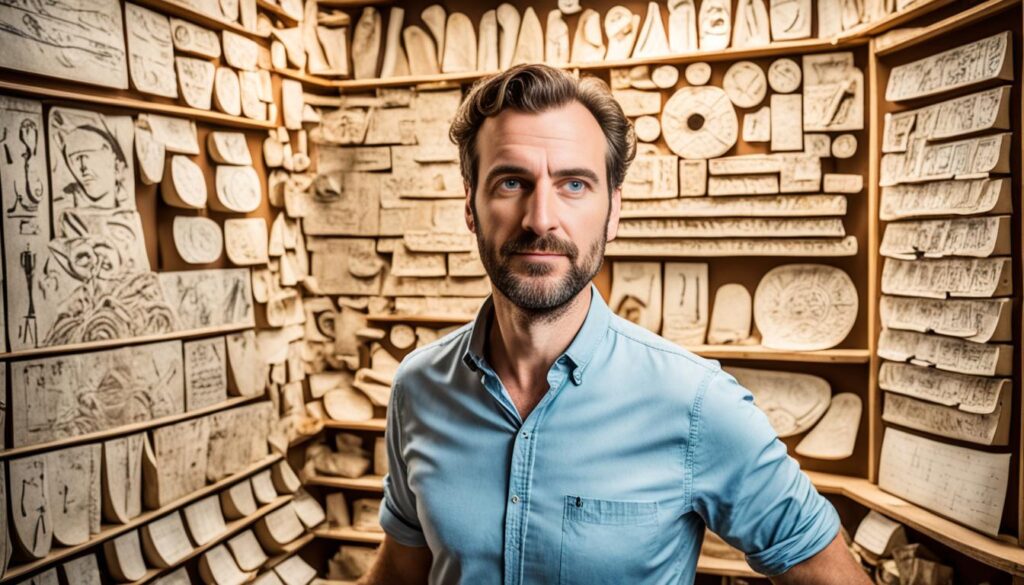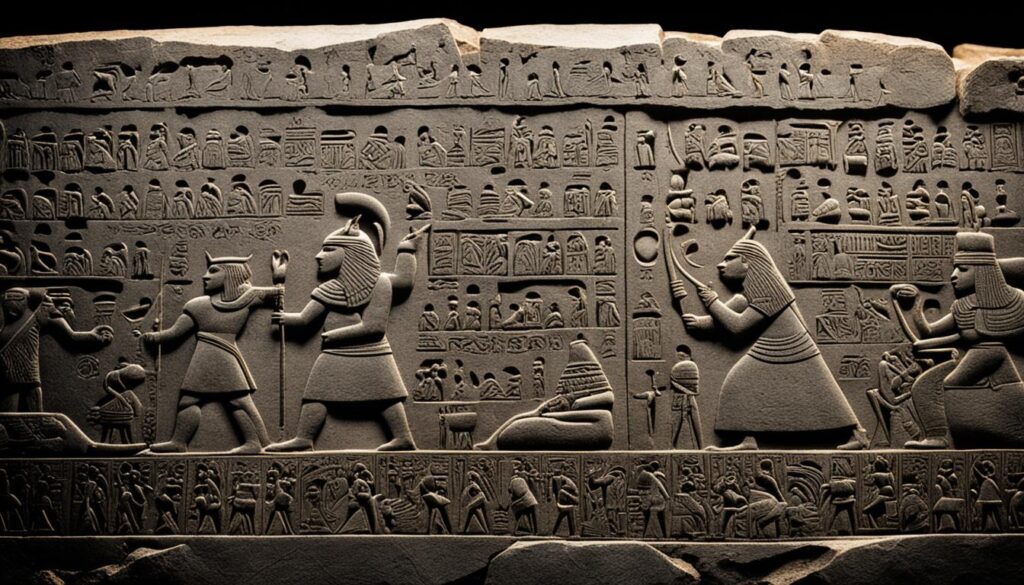The Rosetta Stone is a key artifact that helps us understand ancient Egyptian hieroglyphs. Found in 1799, it has amazed scholars and the public. It connects us to the ancient world’s rich culture.
For centuries, scholars couldn’t figure out Egyptian hieroglyphs. But the Rosetta Stone changed that. It has texts in Egyptian hieroglyphs, Demotic script, and Greek. This helped us unlock the secrets of ancient Egyptian language.
Now, we can better understand the civilizations that lived by the Nile River. The Rosetta Stone is a treasure that connects us to the past.
Unearthing a Priceless Artifact
The discovery of the Rosetta Stone in 1799 changed archaeology and ancient language studies. This black granite slab, from 196 BCE, was found by French soldiers near Rosetta (now Rashid) in Egypt. Its importance comes from its trilingual script, with ancient Egyptian hieroglyphs, Demotic script, and ancient Greek.
The Discovery of the Rosetta Stone
A French engineer named Bouchard found the Rosetta Stone while building a fort. This find was a major breakthrough in understanding ancient Egyptian culture. The stone’s script, in three languages, helped scholars decode the hieroglyphs.
Significance in Deciphering Ancient Scripts
The Rosetta Stone changed how we study ancient scripts. Before, hieroglyphics were a mystery. The Greek text on the stone let scholars compare scripts and decipher hieroglyphics. This led to a deeper understanding of ancient Egyptian culture and history.
The Enigma of Ancient Egyptian Hieroglyphs
For centuries, scholars and linguists around the world struggled with ancient Egyptian hieroglyphs. This complex script was full of symbols for objects, animals, and ideas. It kept the history and culture of ancient Egypt a mystery.
The writing system went back thousands of years. At first, people thought it was just pictures, each one meaning something specific. But as they looked closer, they found it was much more complex. It had sounds and rules like a modern language.
For a long time, people tried to figure out the hieroglyphs. The first big break came in the early 1800s with the Rosetta Stone. This stone had writing in three languages, including ancient Egyptian hieroglyphs.
This stone was a game-changer. It let scholars start to understand the hieroglyphs. Thanks to the Rosetta Stone, we can now learn more about ancient Egyptian culture and history.
Cracking the Code: The Brilliant Minds Behind the Decipherment
In the early 19th century, a French scholar named Jean-François Champollion made a big breakthrough. He worked hard to understand the ancient Egyptian hieroglyphics. Thanks to the Rosetta Stone, Champollion was able to figure out the code. This opened a new chapter in understanding ancient Egypt.
Jean-François Champollion and His Groundbreaking Work
Champollion’s work to understand the hieroglyphs was hard but he didn’t give up. His deep knowledge and careful study led him to a major discovery. He found the sounds of many hieroglyphic symbols by comparing the Rosetta Stone.
This breakthrough changed Egyptology and how we study ancient languages. Champollion’s work revealed a lot about ancient Egyptian life and culture. It showed the power of human intelligence and the drive for knowledge. It motivates scholars and explorers to keep uncovering the secrets of the past.

Historical Curiosities: Unveiling the Mysteries of the Past
The Rosetta Stone is a key example of the fascinating historical curiosities that grab the attention of scholars and the public. These mysterious artifacts from the past unlock the secrets of old times. They give us a peek into the rich culture and knowledge of ancient civilizations.
From the depths of ancient archaeology, these curiosities come to light, revealing the hidden stories of the past. The Rosetta Stone, with its inscriptions in multiple languages, has been crucial in understanding ancient Egypt’s mysterious language. It has captivated many researchers and fans over the years.
There are many more historical curiosities out there, each one offering a unique look into the past. Take the Antikythera mechanism, an ancient Greek device that was like a computer. Or the Terracotta Army, the life-sized soldiers of Qin Shi Huang, China’s first emperor. These items still amaze and inspire us today.
Studying ancient archaeology and cultural heritage, these curiosities are key to piecing together our shared human history. They remind us of the creativity, skill, and strength of past civilizations. They encourage us to dig into the mysteries hidden in the past.
The Rosetta Stone as a Bridge to Ancient Civilizations
The Rosetta Stone is a key artifact from ancient Egypt. It helped unlock the secrets of hieroglyphs and shed light on the culture and beliefs of the time. The stone shows us the religious and social life of ancient Egypt. It tells us about their beliefs, how they ruled, and their interactions with other cultures.
Insights into Egyptian Culture and Beliefs
The Rosetta Stone has three languages on it, making it a doorway to ancient Egyptian culture. It tells us about their religious practices and the gods they worshipped. Scholars have learned a lot about their view of the world and their traditions.
This stone also gives us a peek into how ancient Egypt was governed and taxed. It shows the complex systems they had. We can see how the Greek and Egyptian rulers worked together or apart.
The Rosetta Stone is more than just a tool for deciphering hieroglyphs. It connects us to the ancient Egyptians’ rich culture and beliefs. Through it, we can understand and appreciate the depth and complexity of their civilization.
The Impact on Modern Linguistics and Archaeology
The Rosetta Stone changed the game for linguistics and archaeology. It helped us understand ancient Egyptian language and literature. This discovery also helped us learn about other lost scripts and civilizations.
The Rosetta Stone made a huge leap in linguistics. It connected ancient and modern languages. Scholars could now translate between hieroglyphic, demotic, and Greek scripts. This opened up a world of knowledge about ancient Egypt’s culture and literature.

In archaeology, the Rosetta Stone was a game-changer too. It let us read and understand ancient Egyptian texts. Now, archaeologists can learn more about the past. They can see the social and religious life of ancient Egypt more clearly.
The Rosetta Stone’s impact goes beyond just history and culture. It shows how language can uncover the secrets of the past. It inspires scholars and archaeologists to keep exploring our shared history.
Preserving and Protecting Cultural Heritage
The Rosetta Stone is a key piece in preserving our cultural heritage. It connects us to the past, showing us the history and traditions of ancient civilizations. This stone helped us understand ancient Egyptian hieroglyphs, revealing much about their culture and beliefs.
Keeping artifacts safe is crucial for our cultural heritage. By studying these items, we learn more about our history. The Rosetta Stone has been closely examined by scholars, helping us understand ancient Egyptian language.
The Importance of Safeguarding Invaluable Artifacts
Preserving the Rosetta Stone and other artifacts is vital. They tell us about our ancestors’ lives and achievements. It’s our duty to keep these items safe for future generations.
The Rosetta Stone shows the importance of preserving artifacts. Its discovery changed how we see the past. Keeping it safe means its story will live on for many years.
Decoding Ancient Scripts: A Continuous Journey
The journey of deciphering ancient scripts, like the Rosetta Stone, is ongoing. Scholars and the public find it fascinating. It helps us learn about long-lost languages and mysterious artifacts. This process lets us see the rich history of humans and the cultures that shaped our world.
Archaeologists and linguists around the world are working hard to uncover ancient scripts’ secrets. They study everything from Egyptian hieroglyphs to Mesopotamian cuneiform. Each discovery tells us more about the old civilizations’ customs, beliefs, and achievements. It fills in the gaps in our knowledge and broadens our view of human history.
The Rosetta Stone has inspired this exploration. Its three languages have led to new ways to understand the past. By comparing these languages, we learn about cultural exchange and connections between societies. This deepens our knowledge of archaeology and cultural heritage.
Deciphering ancient scripts is a never-ending journey. It promises to reveal more about human civilization’s diversity. This work honors those who came before us. It also opens doors for future scholars and explorers to discover the past and shape our future understanding.
The Rosetta Stone: A Symbol of Human Ingenuity
The Rosetta Stone is a symbol of human creativity and hard work. It’s an ancient Egyptian artifact with three languages written on it. Scholars and historians have been fascinated by it for centuries. It helped unlock the secrets of the past.
Deciphering the Rosetta Stone was a big achievement in scholarship. It showed the power of critical thinking. It inspired many archaeologists, linguists, and explorers to learn more about ancient civilizations.
The Rosetta Stone is more than just a tool for reading ancient languages. It shows how human creativity can solve tough problems. It’s a reminder of our curiosity and drive to learn about our past.
This artifact symbolizes what we can achieve with hard work, teamwork, and a love for knowledge.
Inspiring Future Generations of Scholars and Explorers
The Rosetta Stone still inspires people all over the world. It motivates scholars and explorers to follow in the footsteps of those who uncovered the past’s secrets. It’s a symbol of human ingenuity, archaeology, and cultural heritage.
Looking at the Rosetta Stone reminds us of the power of our minds. We can solve complex problems, connect different cultures, and learn about our cultural heritage. This artifact shows the amazing things the rosetta stone represents: the human spirit and the power of human ingenuity.
Exploring Other Significant Archaeological Discoveries
The Rosetta Stone is a famous archaeological find, but it’s just a small part of the many discoveries that have changed our view of ancient times. Places like Machu Picchu in Peru and the tomb of Tutankhamun in Egypt are full of secrets waiting to be uncovered. These sites help us learn more about the past.
Machu Picchu sits high in the Andes Mountains and has amazed people for years. It shows us the advanced engineering and culture of the Inca Empire. The discovery of Tutankhamun’s tomb in Egypt also showed us the luxury of ancient Egyptian royalty.
Discoveries like the Terracotta Army in China and the Dead Sea Scrolls in the Middle East have also changed our understanding of ancient civilizations. These finds inspire new generations to explore and learn from the past. They help us keep our cultural heritage alive and encourage others to follow in their footsteps.






